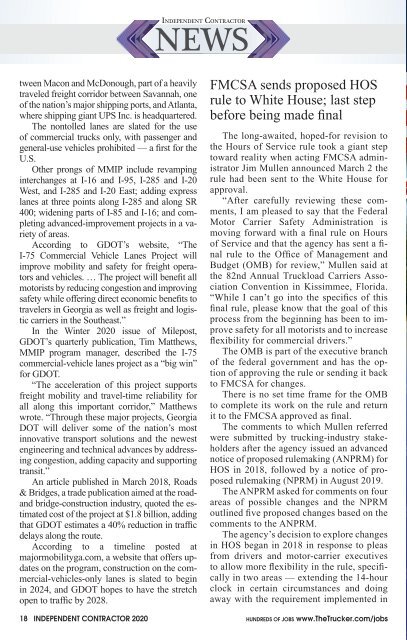2004_IC_AllPages
Create successful ePaper yourself
Turn your PDF publications into a flip-book with our unique Google optimized e-Paper software.
Independent Contractor<br />
NEWS<br />
tween Macon and McDonough, part of a heavily<br />
traveled freight corridor between Savannah, one<br />
of the nation’s major shipping ports, and Atlanta,<br />
where shipping giant UPS Inc. is headquartered.<br />
The nontolled lanes are slated for the use<br />
of commercial trucks only, with passenger and<br />
general-use vehicles prohibited — a first for the<br />
U.S.<br />
Other prongs of MMIP include revamping<br />
interchanges at I-16 and I-95, I-285 and I-20<br />
West, and I-285 and I-20 East; adding express<br />
lanes at three points along I-285 and along SR<br />
400; widening parts of I-85 and I-16; and completing<br />
advanced-improvement projects in a variety<br />
of areas.<br />
According to GDOT’s website, “The<br />
I-75 Commercial Vehicle Lanes Project will<br />
improve mobility and safety for freight operators<br />
and vehicles. … The project will benefit all<br />
motorists by reducing congestion and improving<br />
safety while offering direct economic benefits to<br />
travelers in Georgia as well as freight and logistic<br />
carriers in the Southeast.”<br />
In the Winter 2020 issue of Milepost,<br />
GDOT’s quarterly publication, Tim Matthews,<br />
MMIP program manager, described the I-75<br />
commercial-vehicle lanes project as a “big win”<br />
for GDOT.<br />
“The acceleration of this project supports<br />
freight mobility and travel-time reliability for<br />
all along this important corridor,” Matthews<br />
wrote. “Through these major projects, Georgia<br />
DOT will deliver some of the nation’s most<br />
innovative transport solutions and the newest<br />
engineering and technical advances by addressing<br />
congestion, adding capacity and supporting<br />
transit.”<br />
An article published in March 2018, Roads<br />
& Bridges, a trade publication aimed at the roadand<br />
bridge-construction industry, quoted the estimated<br />
cost of the project at $1.8 billion, adding<br />
that GDOT estimates a 40% reduction in traffic<br />
delays along the route.<br />
According to a timeline posted at<br />
majormobilityga.com, a website that offers updates<br />
on the program, construction on the commercial-vehicles-only<br />
lanes is slated to begin<br />
in 2024, and GDOT hopes to have the stretch<br />
open to traffic by 2028.<br />
FMCSA sends proposed HOS<br />
rule to White House; last step<br />
before being made final<br />
The long-awaited, hoped-for revision to<br />
the Hours of Service rule took a giant step<br />
toward reality when acting FMCSA administrator<br />
Jim Mullen announced March 2 the<br />
rule had been sent to the White House for<br />
approval.<br />
“After carefully reviewing these comments,<br />
I am pleased to say that the Federal<br />
Motor Carrier Safety Administration is<br />
moving forward with a final rule on Hours<br />
of Service and that the agency has sent a final<br />
rule to the Office of Management and<br />
Budget (OMB) for review,” Mullen said at<br />
the 82nd Annual Truckload Carriers Association<br />
Convention in Kissimmee, Florida.<br />
“While I can’t go into the specifics of this<br />
final rule, please know that the goal of this<br />
process from the beginning has been to improve<br />
safety for all motorists and to increase<br />
flexibility for commercial drivers.”<br />
The OMB is part of the executive branch<br />
of the federal government and has the option<br />
of approving the rule or sending it back<br />
to FMCSA for changes.<br />
There is no set time frame for the OMB<br />
to complete its work on the rule and return<br />
it to the FMCSA approved as final.<br />
The comments to which Mullen referred<br />
were submitted by trucking-industry stakeholders<br />
after the agency issued an advanced<br />
notice of proposed rulemaking (ANPRM) for<br />
HOS in 2018, followed by a notice of proposed<br />
rulemaking (NPRM) in August 2019.<br />
The ANPRM asked for comments on four<br />
areas of possible changes and the NPRM<br />
outlined five proposed changes based on the<br />
comments to the ANPRM.<br />
The agency’s decision to explore changes<br />
in HOS began in 2018 in response to pleas<br />
from drivers and motor-carrier executives<br />
to allow more flexibility in the rule, specifically<br />
in two areas — extending the 14-hour<br />
clock in certain circumstances and doing<br />
away with the requirement implemented in<br />
18 INDEPENDENT CONTRACTOR 2020 HUNDREDS OF JOBS www.TheTrucker.com/jobs

















